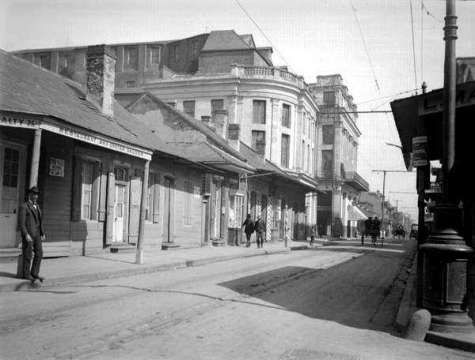Krist, Gary. Empire of Sin: A Story of Sex, Jazz, Murder and the Battle for Modern New Orleans, Crown Publishers, New York, 2014 (414pp.$26).
New Orleans was always a polyglot city in which prosperous Anglo-American planters and merchants built entire neighborhoods of capacious mansions in the “American” part of the town called the Garden District, upriver from Canal Street, setting themselves apart from Creole neighborhoods downtown as well as from the Africans, some descendants of former slaves, who lived Uptown. It was always a bohemian place, full of diseases like yellow fever, and vice merchants like gamblers and whores. It was also a city seething with cultural vitality, where music and dancing went to the bone.
In this unique city, a population explosion had been set off by the Louisiana Purchase. At the beginning of the nineteenth century and for forty years thereafter, an influx of rowdy flatboat-men (French, Spanish and Anglo), the vanguard of a steamboat culture that included card-sharps, pimps, saloonkeepers and confidence men, flooded the city with scalawags, horse racers and prostitutes. The city was wide open, a situation that irked prominent reform-minded Whites, especially when Blacks and Creoles began mixing with Whites in saloons and brothels. For the reform-minded, it only got worse when “jass” music replaced the waltz and tango in cabarets.
Gary Krist, an award-winning journalist and popular historian, is the author of “City of Scoundrels” and “White Cascade”. His work has been recognized with the Lowell Thomas Gold Medal for Travel Journalism and a Sue Kaufman Prize from the American Academy of Arts and Letters. His latest work, Empire of Sin, chronicles the rise and demise of Storyville, a mixed-race working class neighborhood downriver from Canal Street, where, in the mid-1890’s, moral crusader and alderman Sidney Story and his Victorian do-gooder cohorts sought to “isolate” and thus insulate prostitution, gambling, jazz and drugs, so that the “better elements” could rest easier. Out of sight, out of mind, they thought.
It didn’t turn out that way. Giving sin a free hand and a fixed address only accentuated its gaudiness and scope, inviting a kind of freebooting culture that before long became the city’s claim to fame. Not long after 1900, “the District” rose in a rational fashion on each of six cross streets from Canal, including famous Basin Street, a broad avenue that anchored the foot of the District closest to the Vieux Carre and the river. Basin was home to the famous “Five Dollar Houses” catering to the luxury trade where mostly white clients sought opulent exclusivity to share with their white and octoroon paramours. Behind Basin was Franklin, decidedly less high-toned, where smaller brothels, dance halls, honky-tonks and saloons gave the District its reputation for music, especially ragtime and “hot” jazz. Back from there extended Liberty, Marais, Villere and finally Robertson Street, where the cafes, saloons and brothels were both cheap and dangerous. Crossing these were four intersecting streets of ill repute, where the Tenderloin section featured tiny “cribs”, rented out to both black and white prostitutes who worked under the protection of pimps.
Empire of Sin is a meticulously researched and well-written popular history that provides endless insights into the machinations of city politics, the connection between law enforcement and vice, and the by-play among commercialized sex, race relations, modern music and gang crime. Notably, the book features Tom Anderson, the “mayor of Storyville”, whose enterprises included the famous Annex café and its attached brothel, as well as a host of characters like Steel Arm Johnny, Bird Leg Nora, Gold Tooth Gussie and Bull Frog Sunny, as well as notoriously successful madams like “Willie” Piazza. Unfortunately, the story of New Orleans is also the story of race riots and “Black Hand” lynchings during which the respectable people slaughtered Italians and Blacks in large numbers. And of course, ultimately, the Empire of Sin, after being dismantled by strict laws, later became the empire of Apartheid.
To Krist’s credit, he writes authoritatively about jazz and its early days, which makes Empire of Sin a compelling social and artistic document wherein roam the likes of little “Louis” Armstrong, trombonist Kid Ory, the fabulous genius Sydney Bechet, and King Oliver, who was Armstrong’s ticket to Chicago and fame. The success of the reformers in closing down Storyville, also was the cause of a mass exodus of jazz players to Chicago, New York and Kansas City, a migration which set the stage for the evolution of a true American art form.
The Empire of Sin is endlessly fascinating and includes a fine bibliography and generous notes. Missing, sadly, is a good map of New Orleans. The “ax” murders, as lurid as they are, contribute very little to the overall picture of a New Orleans in turmoil at the height of its cultural power and seem to be told by Krist as a kind of sidespin. The Empire of Sin is, however, popular history on a very high level.


